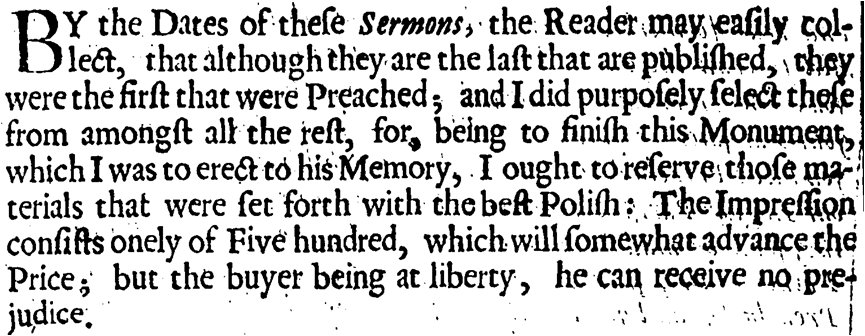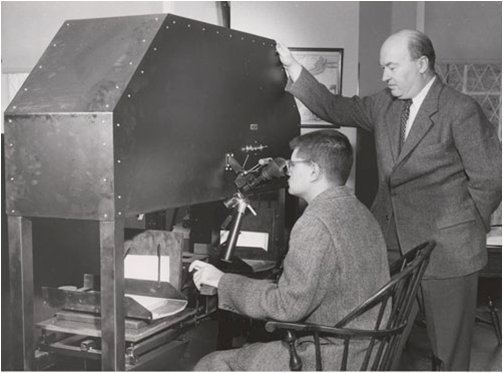Through a Glass Darkly: Collating Donne’s Sermons
This is a tale about mirrors. My plight is that of the Lady of Shalott: ‘moving through a mirror clear / That hangs before me all the year, / Shadows of the world appear’. My shadows are those of the rare books reading rooms in research libraries throughout the country, of readers and librarians moving in and out of view (or of a sunny day observed through two mirrors, through the glass of a window). But my focus, like the Lady’s on her loom, is firmly on the book in front of me: John Donne’s XXVI Sermons (1660/1).
To explain: as the Research Associate for The Oxford Edition of the Sermons of John Donne, I am collating as many copies as possible of all the early prints of Donne’s sermons. Donne’s autograph manuscripts that may have ended up as copy text in the print shop have disappeared without a trace, hence my job involves establishing the best possible text from print, taking account of each and every variant introduced throughout the long and laborious printing process of three large folios and various quarto books.
Collating happens with the help of ‘Hailey’s Comet’, a so-called optical collator. In short, this is a set of portable mirrors on anglepoised stands which allow me to see simultaneously a page in front of me (the actual book in question), and a reproduction on a laptop screen of another copy of the same book. By superimposing the two images (rather like using transparencies) by endlessly twisting and turning the mirrors, and by unlearning my dominant eye’s impulse to see one but not the other image, my brain finally marries both images, after which any variant on the page jumps out in full 3D. The experience is not unlike watching a 3D movie. The printed page gains real visual depth, and the vagaries of early modern printing practice (and XXVI Sermons is a terribly printed book) come sharply into focus. ‘Hailey’s Comet’, devised by Carter Hailey, is a miracle of invention, mostly due to its portability: whilst the very first Hinman collator (allowing Charles Hinman his groundbreaking observations about the composition of Shakespeare’s 1623 Folio) required a large room to house it, the Comet fits neatly into a backpack with room to spare for lunch.
Cambridge University Library is a particularly helpful place to work on Donne’s XXVI Sermons, since the library acquired, in 1982, the collection of Sir Geoffrey Keynes, famous surgeon and bibliographical scholar (see http://www.lib.cam.ac.uk/deptserv/rarebooks/keynes.html). The Keynes collection comprises around 8,000 items, many of which are still kept in Keynes’s own bookcases at CUL, in what is now known as the Keynes room. Apart from many other influential works on English literature and bibliography, Keynes produced the authoritative bibliography of Donne, and owned a significant amount of early printed books by the author, including 4 copies of XVII Sermons. The book in question was issued with three variant title pages, and Keynes owned an example of all three. Keynes’s books made for extremely rich pickings for me as collator. We are fortunate to have the very exact number of XXVI Sermons that were printed, since this information is relayed by John Donne the younger, who saw the volume through the press:

Whether or not Donne the younger was simply fleecing money out the pockets of the seventeenth-century book buyer remains difficult to know for certain – XXVI Sermons is not remotely a ‘polished’ book and so Donne Jr was disingenuous on at least one count. Yet let us for the moment accept that 500 copies were indeed printed. From this print run I have managed to retrace around 50 copies, a very significant amount in light of the normal expected chances of survival for early printed books. Thus around 10% of the print run survives, 1% of which (5 copies) can be consulted side by side at CUL (and a further two, respectively, at King’s and Newnham Colleges) – an unrivalled opportunity to observe print variants and other bibliographical features of the book.
Collating renaissance printed books is an unsettling experience. Firstly comes the initial feeling of seasickness (I have also heard reports of migraines) when tricking your brain that you are seeing one, not two pages at once. But seasickness abates with practice. Physical discomforts overcome, for the intrepid collator the printed page will never give the same static impression of type upon page, as I used to see it. Rather, the early printed page becomes a living organism. Each single impression of each page in a copy of the Sermons is subtly, sometimes unsubtly, different: variously inked, occasionally with a hair caught between press and paper, sometimes with some type knocked out of place, sometimes with the furniture of a forme rearranged, and frequently, with the type reset to correct mistakes. This comes as no surprise to anyone who has ever edited anything from early print – but for the EEBO generation nurtured by the single digitised copies that are freely downloadable, this lesson must continually be taught. Collating books teaches one about the sheer physicality of the printing process, and about the fact that printed texts are not the stable entities they are purporting to be.
In early modern thinking the mirror features as a pervasive metaphor and poetic image, and also as a frequent object in, and subject for, scientific and theological enquiry. Examples abound, so I shall limit myself to one:

So speaks Donne, from his Easter sermon for St Paul’s, 1628 (on I Cor. 13.12, ‘For now we see through a glasse darkly, but then face to face; Now I know in part, but then I shall know, even as also I am knowne’). I will resist the temptation to wrench Donne’s carefully crafted prose out of context: for example, how the sermon text observed through the collator is ‘but a representation onely’; and how the sermon itself, dramatic performance piece par excellence, is only imperfectly present, as if by ‘reflected beams’, in the printed text; and how whatever Donne wrote in manuscript can only imperfectly be reconstructed from print, as if reading ‘through a glasse, darkly’.
Granted, in the already arcane field of textual criticism, the optical collator takes the prize for most unlikely contraption to take into a library. Yet renaissance readers loved mechanical reading aids (see Ramelli’s famous ‘Reading Wheel’; for a recent attempt to actually build this fantastical machine, see here: http://greg.org/archive/2010/09/20/on_the_making_of_the_lost_biennale_machines_of_daniel_libeskind.html#more).
We might not catch our glimpse of God, yet in light of such reading machines it feels curiously appropriate to examine the renaissance book through two collating mirrors.
Sebastiaan Verweij is the Research Associate for The Oxford Edition of the Sermons of John Donne (see http://www.cems-oxford.org/donne ). He previously worked on Scriptorium at Cambridge (http://scriptorium.english.cam.ac.uk/ ) and designed this CMT website, so this Gallery exhibit is his parting shot.

1. The Hinman Collator. Courtesy of http://www.encyclopediavirginia.org/media_player?mets_filename=evm00000595mets.xml.

2. The Comet (and Sebastiaan) at work in the Cambridge University Library.